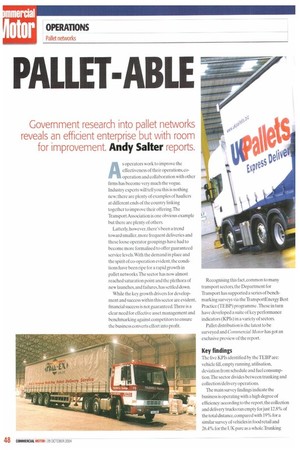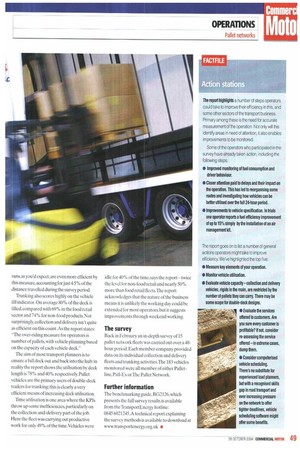PALLET-ABLE
Page 50

Page 51

If you've noticed an error in this article please click here to report it so we can fix it.
Government research into pallet networks reveals an efficient enterprise but with room for improvement. Andy Salter reports.
As operators work to improve the effectiveness of their operations, cooperation and collaboration with other firms has become very much the vogue. Industry experts will tell you this is nothing new; there are plenty of examples of hauliers at different ends of the country linking together to improve their offering.The Transport Association is one obvious example but there are plenty of others.
Latterly, however, there's been a trend toward smaller, more frequent deliveries and these loose operator groupings have had to become more formalised to offer guaranteed service levels. With the demand in place and the spirit of co-operation evident, the conditions have been ripe for a rapid growth in pallet networks.The sector has now almost reached saturation point and the plethora of new launches, and failures, has settled down.
While the key growth drivers for development and success within this sector are evident, financial success is not guaranteed.There is a clear need for effective asset management and benchmarking against competitors to ensure the business converts effort into profit. Recognising this fact, common to many transport sectors, the Department for Transport has supported a series of benchmarking surveys via the TransportEnergy Best Practice (TEBP) programme .These in turn have developed a suite of key performance indicators (KPIs) in a variety of sectors.
Pallet distribution is the latest to be surveyed and commercial Motor has got an exclusive preview of the report.
Key findings
The five KPIs identified by the TEBP are: vehicle fill, empty running, utilisation, deviation from schedule and fuel consumption.The sector divides between trunking and collection/delivery operations.
The main survey findings indicate the business is operating with a high degree of efficiency: according to the report. the collection and delivery trucks ran empty forjust 12.8% of the total distance, compared with 19% for a similar survey of vehicles in food retail and 26.4% for the UK parc as a whole.Trunking runs, as you'd expect,are even more efficient by this measure, accounting for just 4.5% of the distance travelled during the survey period.
Trunking also scores highly on the vehicle till indicator. On average 80% of the deck is tilled, compared with 69% in the food retail sector and 74% for non-food products. Not surprisingly, collection and delivery isn't quite as efficient on this count. As the report states: "The over-riding measure for operators is number of pallets, with vehicle planning based on the capacity of each vehicle deck."
The aim of most transport planners is to ensure a full deck out and back into the hub: in reality the report shows the utilisation by deck length is 78% and 40% respectively. Pallet vehicles are the primary users of double-deck trailers for trunking: this is clearly a very efficient means of increasing deck utilisation.
Time utilisation is one area where the K.Pls throw up some inefficiencies, particularly on the collection-and-delivery part of the job. Here the fleet was carrying out productive work for only 49% of the time.Vehicles were idle for 40% of the time, says the report twice the level for non-food retail and nearly 50% more than food retail fleets The report acknowledges that the nature of the business means it is unlikely the working day could be extended for most operators, but it suggests improvements through weekend working.
The survey
Back in February an in-depth survey of 15 pallet network fleets was carried out over a 48hour period. Each member company provided data on its individual collection and delivery fleets and trunking activities. The 183 vehicles monitored were all member of either Palletline, Pall-Ex or The Pallet Network.
Further information
The benchmarking guide, BG2 I 26,which presents the full survey results is available from the TransportEnergy hotline: 0845 6021245.A technical report explaining the survey methods is available to download at www.transportenergy.org.uk •






























































































































































































